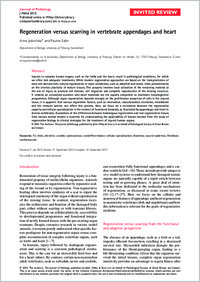Regeneration versus scarring in vertebrate appendages and heart
- Jaźwińska, Anna Department of Biology, University of Fribourg, Switzerland
- Sallin, Pauline Department of Biology, University of Fribourg, Switzerland
-
01.10.2015
Published in:
- The Journal of Pathology. - 2016, vol. 238, no. 2, p. 233-246
English
Injuries to complex human organs, such as the limbs and the heart, result in pathological conditions, for which we often lack adequate treatments. While modern regenerative approaches are based on the transplantation of stem cell-derived cells, natural regeneration in lower vertebrates, such as zebrafish and newts, relies predominantly on the intrinsic plasticity of mature tissues. This property involves local activation of the remaining material at the site of injury to promote cell division, cell migration and complete reproduction of the missing structure. It remains an unresolved question why adult mammals are not equally competent to reactivate morphogenetic programmes. Although organ regeneration depends strongly on the proliferative properties of cells in the injured tissue, it is apparent that various organismic factors, such as innervation, vascularization, hormones, metabolism and the immune system, can affect this process. Here, we focus on a correlation between the regenerative capacity and cellular specialization in the context of functional demands, as illustrated by appendages and heart in diverse vertebrates. Elucidation of the differences between homologous regenerative and non-regenerative tissues from various animal models is essential for understanding the applicability of lessons learned from the study of regenerative biology to clinical strategies for the treatment of injured human organs.
- Faculty
- Faculté des sciences et de médecine
- Department
- Département de Biologie
- Language
-
- English
- Classification
- Biological sciences
- License
-
License undefined
- Identifiers
-
- RERO DOC 257829
- DOI 10.1002/path.4644
- Persistent URL
- https://folia.unifr.ch/unifr/documents/304549
Statistics
Document views: 122
File downloads:
- pdf: 183
